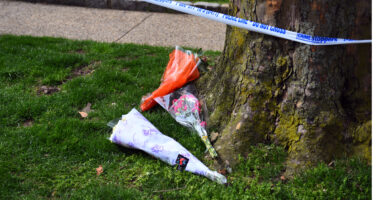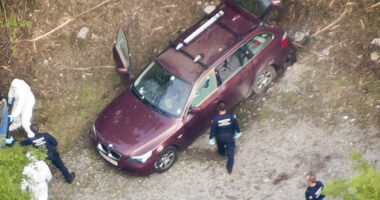A POWERFUL “bomb cyclone” storm is on track to hit the Northeast this weekend after blanketing areas like Kansas City with snow.
The winter storm, named Winter Storm Quinlan by the Weather Channel, could bring heavy rain, thunderstorms, damaging winds, snow, and a blast of cold to the Eastern US in particular, AccuWeather reported.
“Confidence is growing for a significant storm that will bring wide-reaching impacts,” AccuWeather Meteorologist Alex DaSilva said.
Parts of Missouri felt the brunt of Winter Storm Quinlan on Thursday, and anywhere from 2 to 5 inches of snow fell in the Kansas City metro area, according to the Weather Channel.
A bomb cyclone, also known as bombogenesis, “occurs when a mid-latitude cyclone rapidly intensifies,” according to the National Oceanic and Atmospheric Administration.
Read our Winter Storm Quinlan path tracker blog for the latest updates…
-
Storm timing, continued
On Friday night, as colder air is pulled into the storm, rain will change to snow in parts of the Ohio and Tennessee valleys, the Weather Channel noted.
That could occur as far south as northern Mississippi, northern Alabama, and northern Georgia.
Slippery roads could be a concern in parts of the Tennessee Valley.
-
Storm timing
On Friday, snow should fall as far south as Oklahoma, as well as in northern and western Texas and the Ozarks, according to The Weather Channel.
The snow band could extend northeastward into the mid-Mississippi Valley and parts of the Great Lakes as well, which would include the Dallas – Ft Worth metro area.
-
Freezing in Kansas City
A winter weather advisory remained in effect earlier this morning in Kansas City, KMBC News reported Friday.
Roads in the area could refreeze as the temperature there is likely to dip into the single digits Saturday morning.
-
Winter weather alerts issued
Winter weather alerts have been issued by the National Weather Service along the whole path of the storm, the Weather Channel reported.
Areas from the southern Plains to the mid-South, Ohio Valley, Appalachians, and interior Northeast are all impacted.
-
Possible tornadoes
Parts of Florida, Georgia, and the eastern Carolinas could see a small tornado threat emerge Friday night into Saturday as part of the developing storm.
-
Merging storm patterns
The jet stream will be forced southward later this week as two disturbances, one in the Southwest and another over southern Canada merge over the Midwest.
This will drag bitterly-cold air toward the East Coast this weekend.
That will clear the way for a more robust disturbance to move southeast out of northern Canada on Friday, traveling over the Great Lakes and hitting New York, Pennsylvania, and New England.
The third disturbance is then expected to merge with the previous two, creating an area of low pressure and the formation of coastal storms along the East Coast, and that low-pressure zone is forecast to strengthen speedily enough to be classified as a “bomb cyclone”.
-
Damaging winds
Wind gusts could vary between 40-50mph in the Mid-Atlantic as well as the Northeast during Winter Storm Quinlan.
AccuWeather predicts “gusty thunderstorms” will be part of this storm.
-
What are winter storms?
Winter storms, like other forms of storms, begin with wet air ascending into the atmosphere.
At a cold front, rising air occurs when warm air is elevated above cold air, which is essential for cloud formation and precipitation.
As air flows up a huge hill or mountain, it may also rise.
-
Winter storm deaths in 2020
According to Statista, six lives were claimed in 2020 from winter storms.
More people died that year from extreme cold, as 13 lives were lost.
-
How winter storms cause deaths
Most who die from winter storms are not killed by the weather itself.
A majority of the deaths are traffic accidents on icy roads.
Some also die from heart attacks while shoveling snow, and hypothermia from prolonged exposure to cold weather.
-
What is a winter weather warning?
A winter weather warning indicates that a storm is more than likely in your area, and you should take action immediately.
Expect dangerous conditions and try to avoid travel.
-
What is a winter weather watch?
A winter weather watch indicates that there is potential for severe winter weather.
If a winter weather watch is issued, prepare for dangerous weather conditions.
-
What is a winter weather advisory?
A winter weather advisory is an indication that winter weather conditions are likely.
However, the conditions expected are not severe enough to warrant a warning.
-
Drink water to stay safe
Drinking water in the winter is vital to your safety, The Weather Channel explained.
“You can still get dehydrated in the winter,” the outlet said in a video, but you’re less likely to realize it.
Dry winter air makes sweat evaporate more quickly, so you may not realize the severity of dehydration as quickly as in the summer months.
“Drink more water, especially when exercising outside,” The Weather Channel advised.
-
Why should you warm up slowly?
Even though it’s tempting to hop into a hot bath, sauna, or jacuzzi after coming in from the cold, you may be putting yourself at risk.
“Exposure to intense heat is not a way to treat hypothermia,” The Weather Channel warned.
“If you soak in a jacuzzi it can be very painful for your skin, and even cause a heart attack.”
Try heating up after extreme cold exposure by applying warm washcloths to the body, or using strategically-placed hot water bottles.
-
Don’t seek refuge in your car
Even though it may function as a temporary shelter from a winter storm, you should avoid waiting out winter conditions in your car.
“Sheltering in a trapped vehicle can be dangerous,” experts at The Weather Channel explained.
A car’s metal frame creates “a very frigid situation,” and regulating temperature inside the car can be tricky.
Running your engine may not be a safe solution, either.
“Only do so if you know that you can keep the exhaust pipe clear,” The Weather Channel’s winter safety video explains.
“Snow and slush buildup around the pipe can block the exhaust and cause carbon monoxide poisoning.”
-
High winds can reportedly trigger migraines
When it’s blowing a gale outside, the body can react as if it is under attack and produce so-called fight or flight reflexes, such as raised heart rate and heightened emotions.
And high winds can also trigger a migraine.
One reason is the effect on the hypothalamus, the area of the brain that monitors the body’s functions; it can lead to constriction or swelling of the blood vessels in the head which can cause the pain associated with migraine.
Scientists at the University of Calgary in Canada looked at the links between migraine sufferers having an attack and the occurrence of Canadian ‘Chinook’ winds – warm westerly winds specific to Alberta, Canada, which have a definite onset time and are an indicator of profound weather change.
Of 75 patients studied, 32 were more likely to have migraines during Chinook weather conditions than on days without them.
-
Why joint pains can signal rain
Damp weather does seem to make joint pain and osteoarthritis worse.
While there is no conclusive evidence to explain this, it may be due to pressure receptors (baroreceptors) in the joint sensing the drop in atmospheric pressure when the weather changes from dry to rainy.
The level of fluid in the joint then fluctuates in response to these changes, which might trigger pain in the nerves.
-
Winter storm names
These are the names the Weather Channel chose for winter storms during the 2021 to 2022 season:
- Atticus
- Bankston
- Carrie
- Delphine
- Elmer
- Frida
- Garrett
- Hatcher
- Izzy
- Jasper
- Kenan
- Landon
- Miles
- Nancy
- Oaklee
- Phyllis
- Quinlan
- Rachel
- Silas
- Tad
- Usher
- Vega
- Willow
- Xandy
- Yeager
- Zion
-
Why did the US start naming storms, continued
Established by the World Meteorological Organization, a list of names are now used to identify Atlantic hurricanes on a six-year rotation.
The only time that there is a change is if a storm is so deadly or costly that the future use of its name on a different storm is considered inappropriate.
In the event that more than twenty-one named tropical cyclones occur in a season, a supplemental list of names are used.
As for winter storms, The Weather Channel has been naming winter storms since the 2012-2013 winter season.
-
Why did the US start naming storms?
Tropical storms and hurricanes were tracked by year and the order they occurred until the early 1950s.
However, over time, it was discovered that distinctive names would be needed to reduce confusion and streamline communications when two or more tropical storms occur at the same time.
That came after storm advisories broadcast from radio stations were mistaken for warnings concerning an entirely different storm located hundreds of miles away.
-
Aftermath of a winter storm, continued
Chubb.com recommends that you follow these steps after a winter storm has passed:
- Clear the snow
- Clean off your roof
- Look for damage to trees
- Make sure smoke and carbon monoxiode detectors are working
- Check the insides of your home
- Don’t foget about your pets
- Stay warm
- Avoid driving right away
-
Dealing with the aftermath of a winter storm
There are always challenges to deal with after a winter storm, whether you got two inches or two feet of snow, especially if you lose electricity.
Even if your electricity doesn’t come back on right away, here are some recommendations for digging out swiftly, cleaning up efficiently, and staying safe and warm.
-
Keep your pets safe, continued
Follow these recommendations to keep your pets safe and healthy during a winter storm:
- Keep pets indoors
- Provide outdoor shelter for outdoor pets
- Care for your pets’ feet
- Provide extra food and water
- Use leashes when walking near water
- Don’t leave pets locked inside a car
- Keep antifreeze out of reach of pets
- Check vehicles before starting cars to avoid hazards involving pets
-
Keep your pets safe
Chapped paws and itchy, flaky skin can result from exposure to the dry, cold air of winter, as well as chilling rain, sleet, and snow, but these aren’t the only problems that dogs face.
If chemicals from ice-melting products are licked off of bare paws, winter walks can turn harmful.
Mass.gov revealed experts’ suggestions to help avoid cold weather hazards from hurting your pet’s health.









